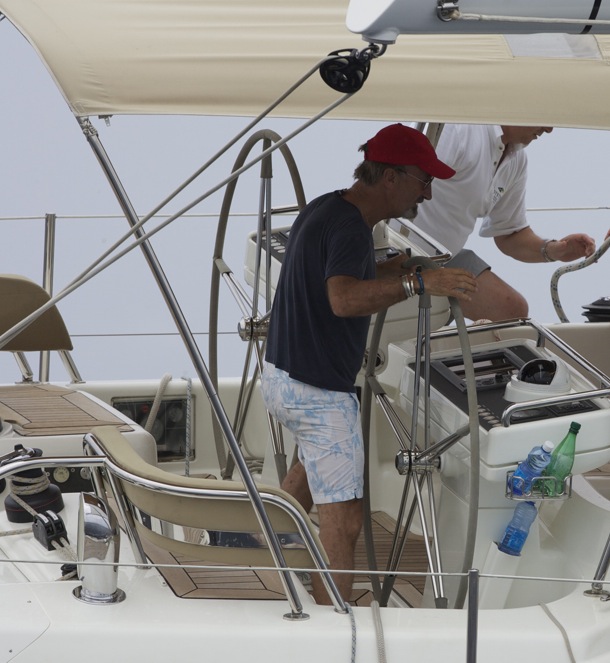Displaying items by tag: F1
#AmericasCup - Sir Ben Ainslie's America's Cup team is already a serious prospect where it counts on the water. But now they're stepping up on the business side of things after signing former McLaren F1 team principal Martin Whitmarsh to lead the charge.
As YBW.com reports, Whitmarsh will join Ben Ainslie Racing (BAR) as chief executive next month – marking the second significant connection between high-performance yachting and Formula 1 after BAR's partnership with Red Bull Racing's chief designer Adrian Newey.
“I’m delighted that Martin is joining us," said Sir Ben in a statement on the announcement earlier this month. "When we first started to put together the plan for BAR, McLaren were one of the aspirations.
“So it’s particularly appropriate to have one of the original architects of that model as our new CEO."
Whitmarsh joins BAR after 25 years with McLaren, during which he worked up the ranks to CEO of the McLaren Group but is best remembered for his stint as the company's F1 team boss from 2009 to 2013, when he was ousted after an uncompetitive season.
He will take the reins of a hopeful upstart team that's already taken to the waters of Bermuda where the next America's Cup racing will get underway two years from now.
But according to My Sailing, their training will also be conducted on dry land thanks to the latest 3D simulation technology borrowed, appropriately, from the F1 world.
The virtual reality simulator was developed by Dr James Roche, himself a former McLaren employee, who used similar tech to help Lizzy Yarnold to Olympic gold for Britain at Sochi earlier this year.
My Sailing has more on the story HERE.
Eddie Jordan Racing...On Water
Irish F1analyst Eddie Jordan might be better known for exploits on tarmac than the high seas but it did not stop the 63-year old Dubliner sailing a smart race to win in the south-eastern Caribbean Sea today in day one of the Oyster Regatta writes Louay Habib. But the F1 man's powerful Oyster 655, Lush was pushed all the way by Chris Shea's Oyster 72, Magrathea.

Eddie Jordan at the helm of the Oyster 655, Lush. Photo: Ingrid Abery
Grenada's lush, green paradise relies on rain and on the morning of Lewmar Race Day, the Oyster Fleet certainly got that. But despite the torrential downpour, the mood in Port Louis was up beat and all of the fleet left the dock, to perform a parade of sail, before heading out to the race area.
As if by magic, shortly after the start an easterly wind blew away the rain clouds. Providing dry, if somewhat tricky conditions. During the course of the day, there were numerous wind shifts, predicting these changes was the secret to success. A light airs start was followed by a building breeze, which piped up to fifteen knots by the end of the race.
Starts are always important but especially in fickle breeze and the Polish Oyster 46, SunsuSea, judged the line to perfection, to get away well. Owned by Mariusz and Paulina Kierebinscy, SunsuSea came to the Caribbean in the 2009 ARC.
"We have been really delighted with the boat." Smiled Mariusz. "My family love to sail, especially in the Caribbean. This is our second Oyster Regatta and although we have little experience with racing, it is a great way to learn how to improve our sailing technique."
Besides Mariusz and Paulina, SunsuSea is crewed by their family and friends. Daughter Claudia and son Martin are fast learners in the cockpit. Whilst friends, Artur and Margaret trim the mainsail, helped by their daughter Adriana, who is just 11 years of age.
"We really like Grenada." Continued Mariusz. 'It is such a friendly place and safe for our children. After the regatta, we will be cruising through The Grenadines to St. Lucia, our last adventure before the boat returns across the Atlantic."
In Class One, Lush, with F1 racing analyst, Eddie Jordan on board, sailed a smart race to win, but the powerful Oyster 655 was pushed all the way by Chris Shea's Oyster 72, Magrathea, who sailed a near perfect beat by using the lifting breeze, along Grande Anse Beach. Jonathon and Jane Mould's Oyster 72, Koluka claimed a well-deserved third in class.
Alan Brook, taking part in his first Oyster regatta as a competitor with his wife Sue in their Oyster 56, Sulana, won the first race in Class Two, the meticulously prepared yacht was extremely well positioned on the racecourse to win by a fair margin. Scott Bickford's American Oyster 53, Contingency was second and Ian Galbraith and crew, racing his Oyster 53, Jigsaw, kept their concentration to take third.
After the fleet had returned to the safe confines of Port Louis Marina, a cocktail party, hosted by the Marine and Yachting Association of Grenada, was full of talk about the day's events.
Later that evening, the Oyster family was treated to a lavish party at the exclusive LaLuna Estate. Tucked away south of the capital, LaLuna is the hidden gem of Morne Rouge Bay, which offers one of the finest beaches on the island, just minutes from St George's. The estate is often frequented by stars of the stage and film and provided a truly magical occasion for the second Oyster party of the regatta.
The ultra-chic secluded venue has a rustic charm extenuated by the use of traditional Caribbean materials to provide a design-fusion, which is unmistakably Asian in appearance. The wooden beachfront courtyard blends cane, cotton, and thatch and inviting day beds are scattered throughout the resort with sublime views of the perfect beach.
The Oyster family enjoyed a mouth watering four-course dinner with fine wine in a wonderful atmosphere. Afterwards, a company of dancers electrified the atmosphere and very soon the party was a very lively affair. It may have been a day of mixed fortunes on the water but the Oyster crew-conga, snaking through the LaLuna's courtyard, was testament to a very successful first day's racing at the Oyster Regatta in Grenada.
Racing resumes on Wednesday 13th April with a coastal race sponsored by Pelagos Yachts, finishing at Le Phare Bleu Marina, on the south coast of Grenada, where the fleet will overnight.

























































